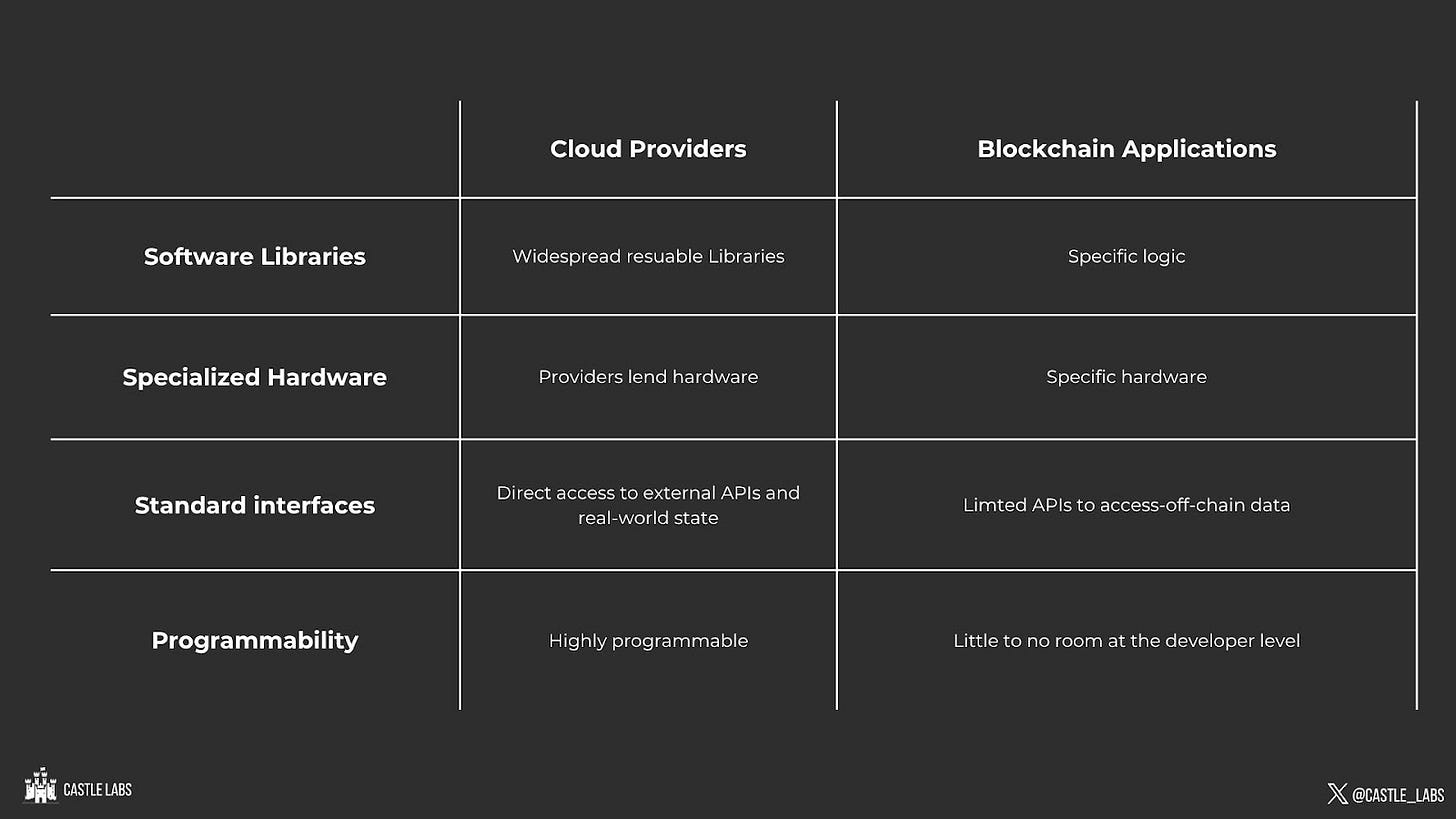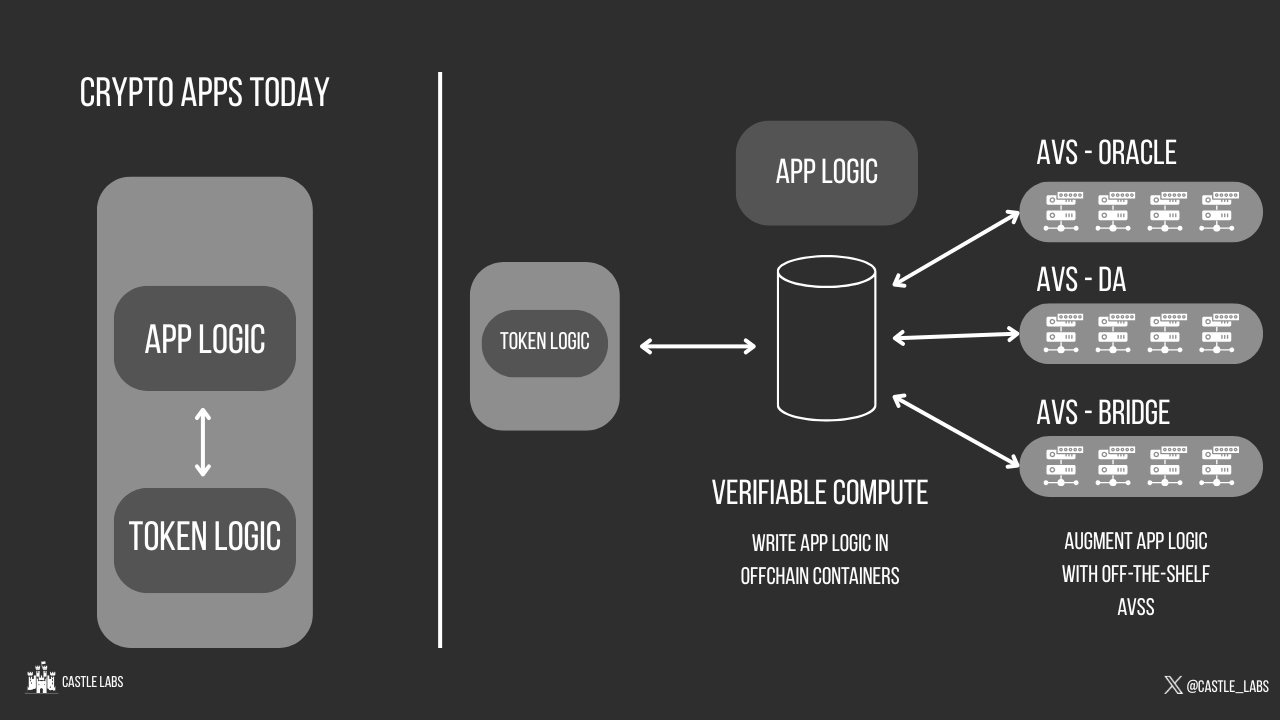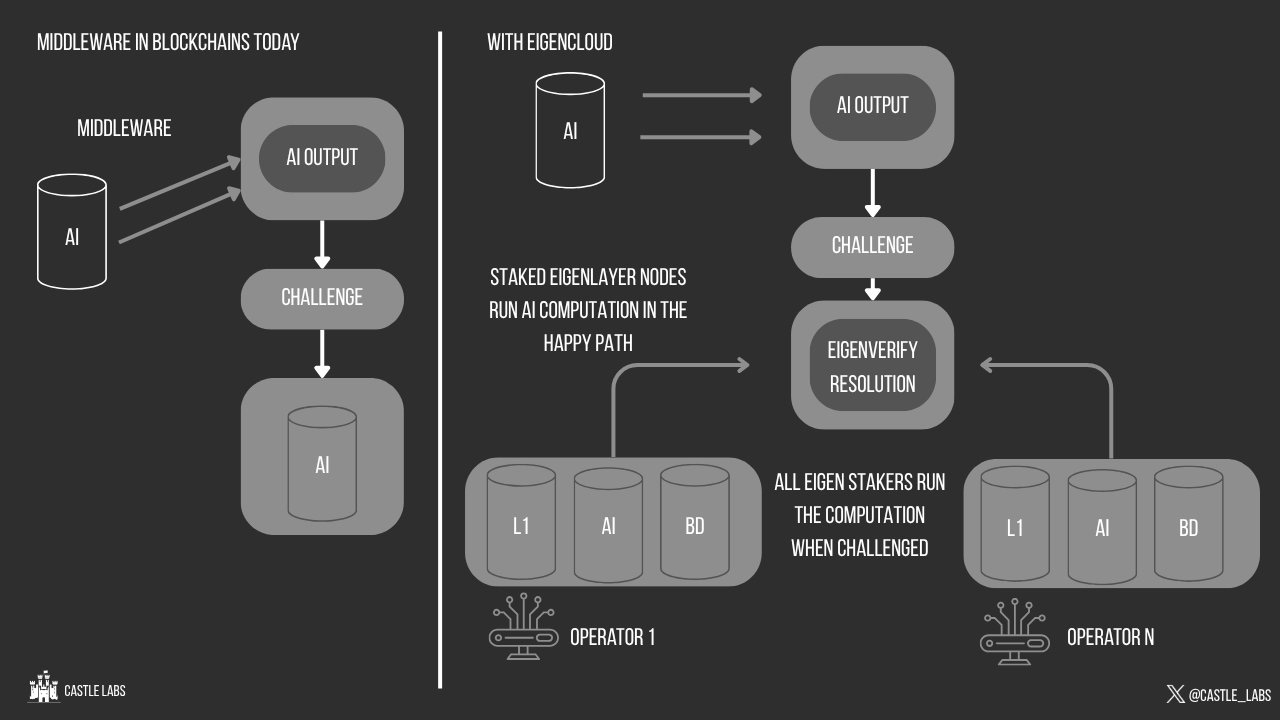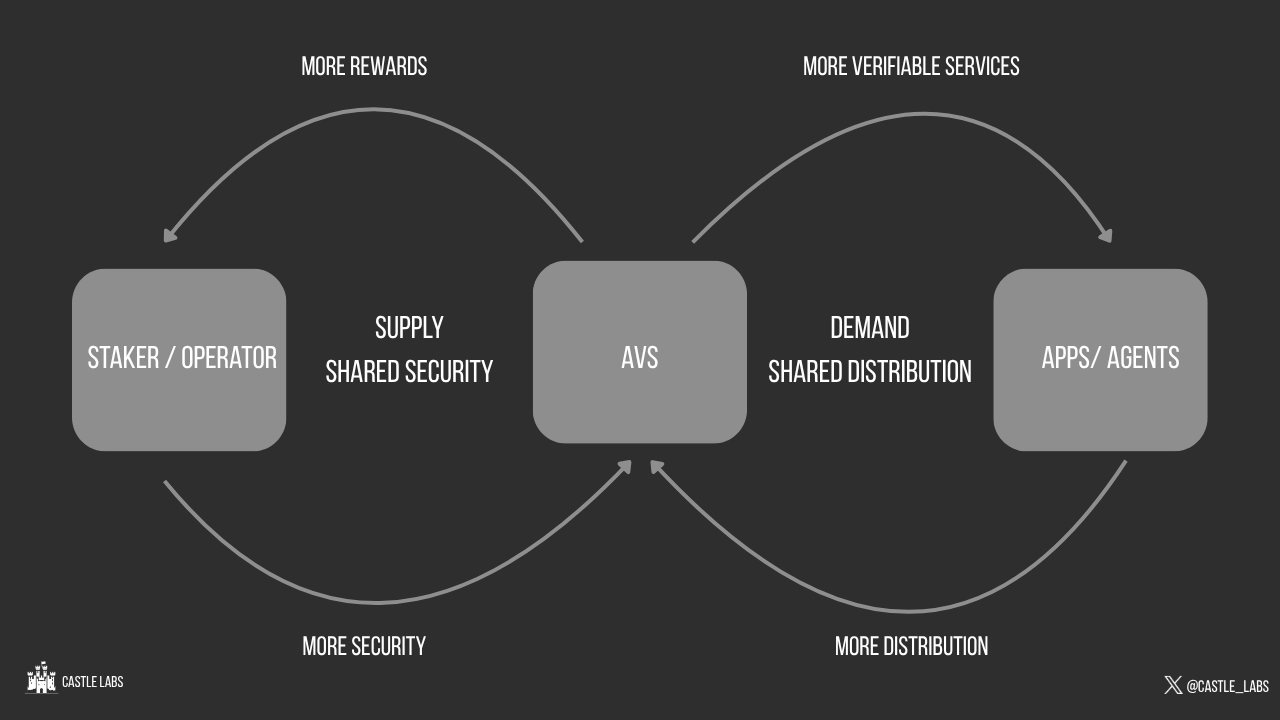Introducing EigenCloud: Enter the Verifiable Cloud Era
Last month, Bob the Builder, a blockchain developer, attempted to build a to-do list onchain, as he wanted to let users prove their task history. Twenty minutes into the task, he met Ethereum’s limits: storing a single 25-item list would require an entire block, cost multiple dollars in gas, and force him to rewrite every JavaScript function in Solidity. A feature that had been a drag-and-drop deploy in Web2 suddenly demanded oracle gymnastics and a PhD in block-size just to tick off that you bought milk today.
Bob’s frustration points to a deeper truth: crypto excels at verifiable and code-enforced coordination, yet, 15+ years later after Bitcoin, it still faces tight constraints on programmability. While traditional clouds provide limitless libraries, elastic hardware, and endless scalability, they come with tradeoffs in terms of centralization. Blockchains, on the contrary, provide trust-minimized verifiability, but they suffer from painful scaffolding.
A better approach must be possible, with the need to create blockchain-native systems that can provide programmability while maintaining the verifiability characteristic of blockchains.
This article introduces EigenCloud, EigenLayer’s native “verifiable cloud”, which promises cloud-grade flexibility without sacrificing crypto’s verifiability.
In this report, we’ll:
Define the programmability dilemma for builders
Introduce how Eigencloud bridges the gap
Explore concrete use cases and the role of the EigenCloud token within the broader EigenLayer stack.
By the end, we’ll see how EigenCloud will make Bob’s life much easier, allowing blockchain applications to power a truly verifiable economy.
The Programmability Dilemma
Bob's struggle with his to-do list wasn't unique. He hit a wall many Web3 builders face: a trade-off between what's easy to build and what's truly verifiable. We refer to this as the Programmability Dilemma.
What do we mean by programmability? Imagine trying to cook.
High programmability is like having a kitchen stocked with every ingredient, utensil, and appliance, which allows you to cook almost any dish.
Low programmability is like having only a microwave and a can of beans. You can make something, but your options are limited.
Bob found Web2 like the fully stocked kitchen, and current Web3 like the microwave-and-beans setup for his specific feature.
What about verifiability? Think of it like a public scoreboard for a game that everyone can see and no single person can secretly change. If points are scored according to the rules, they appear on the board, and everyone trusts it.
EigenCloud aims to bridge the gap between the inherent verifiability of blockchains and their current limitations in programmability, compared to traditional cloud computing.
Blockchain systems are unique in their ability to verify the validity of transactions on their networks. Bitcoin ushered in the era of “verifiable money” with a permissionless ledger ensuring scarcity and a set schedule for minting 21 million BTC. Ethereum pushed this forward, expanding what’s possible to build on top of smart contracts, with the advent of decentralized finance, which kickstarted the second era of crypto: verifiable finance.
The next significant step is the development of a “verifiable economy”, with blockchain applications able to disrupt traditional markets and expand beyond financial use cases. This expansion has been hindered due to the limitations that developing decentralized networks impose on developers in terms of programmability.
The development of blockchain-based applications is inherently more complex than Web2 applications, characterized by an absence of the “programmable infrastructure” offered by traditional infrastructure providers:
Software: Blockchain developers are restricted in the libraries they can use, as they need to re-implement their software to operate within Virtual Machine environments (e.g. EVM, SVM).
Hardware: Developers are restrained by specialized hardware that they cannot request or provision, such as GPUs, high-performance CPUs, or Trusted Execution Environments (TEEs), for their onchain application needs.
Standard Interfaces: Blockchains struggle to securely and verifiably interact with the outside world. Getting external data (such as a stock price) or information onto the blockchain in a trustworthy manner is a major hurdle, often relying on oracles that have their own trust assumptions.
Limited Programmability: Blockchains operate according to their consensus protocol, constricting programmability at the developer level.
At its current state, the development of blockchain applications is highly restricted by the limitations we just presented. One might question whether traditional cloud providers, such as Amazon AWS, could sufficiently address these challenges. They can offer only partial solutions, as they lack the verifiability typical of blockchain environments and present their own sets of challenges, including centralization.
To achieve a balance in development complexity between Web3 and Web2 applications, foundational programmability is paramount.
The current state of the art underscores the necessity for a connection between crypto verifiability and a programmable cloud infrastructure that natively integrates with it.
EigenCloud: Bridging the Gap with a New Architecture
EigenLayer’s solution for this challenge is EigenCloud, a verifiable cloud ecosystem “for application builders to build cloud-scale applications with crypto-grade verifiability”.
At the heart of EigenCloud's approach is a new architecture: Instead of forcing all logic onto the blockchain (like Bob trying to cram his entire to-do list logic onchain), it allows developers to move complex parts of their application logic into what is referred to as a “verifiable offchain container”, while retaining consensus-related logic onchain.
Imagine Bob wants his to-do list to have a complex feature that suggests task priorities based on his past completion patterns: Performing all that math on the blockchain is like asking a very busy and expensive accountant to do basic arithmetic - slow and costly.
EigenCloud says: Bob, do that complex math off the blockchain, in a separate, secure container which runs your calculations quickly and cheaply (think of it like a super-transparent workroom). Then, it just sends onchain the results and a verifiable proof that the work was done honestly, without cheating. In EigenCloud the blockchain does not do all the heavy lifting for the app's complex features. It only handles essential token logic and checks the proofs from these offchain workrooms.
This approach fundamentally changes how decentralized applications can be built:
For Bob, this means he could write much of his task management logic to run efficiently in this offchain container. Only minimal logic related to tokens or final state changes might remain onchain.
This saves valuable onchain capacity to build higher-priority implementations and expands the design space for novel applications.
But if the work happens offchain, how do we trust it's done correctly?
Crucially, EigenCloud preserves the verifiability typical of blockchain networks.
The data within EigenCloud containers is perpetually verifiable, as its integration within EigenLayer, secured by staked tokens, confers economic security. Operators running these containers stake crypto as collateral, like putting down a large security deposit. If they act maliciously or their container produces a wrong result, their staked crypto can be "slashed" (permanently lost). This powerful financial disincentive is key to ensuring honest behavior.
Autonomous Verifiable Services (AVSs)
Another advantage of EigenCloud is to allow developers to tap into EigenLayer’s AVS network.
Let’s assume Bob wants to leverage some offchain capability that is already utilized, such as obtaining a reliable, tamper-proof price feed for a token or ensuring a random number for his game is truly random.
Instead of building that complex verifiable from scratch, he can plug in and leverage AVS to introduce verifiable services within his application.
Think of AVSs as specialized, highly trustworthy, ready-to-use services. One might dispense verifiable weather data, another provides verifiable random numbers, and another offers secure and cost-effective data storage (like EigenDA, which is itself an AVS). Because they're secured by EigenLayer’s shared security (with operators staking collateral that can be slashed), you can trust them to do their specific job correctly.
Under the hood, AVSs can utilize a variety of sophisticated technologies to achieve this verifiability, such as Zero-Knowledge proofs or a network of Trusted Execution Environments (TEE).
The ability to compose these verifiable “building blocks” means developers can now tackle a much wider range of applications, many of which were previously too complex or risky to build verifiably onchain.
This opens the door to applications like:
Verifiable Credit Score
Verifiable AI Governance
Verifiable Defi Vaults
Verifiable Casinos
Verifiable Media
Compared to custom containers, AVSs are much easier to manage in terms of development and maintenance, they accommodate a wide range of operator nodes and trust models, and are cheaper due to their specialization.
Why EigenCloud?
So, what does this new architecture of offchain verifiable containers and a rich ecosystem of AVSs actually mean for builders like Bob? EigenCloud offers several compelling advantages:
Build More, Code Less (Onchain): Developers can move complex, computationally intensive application logic offchain. This means less restrictive onchain coding, faster development cycles, and the ability to build features previously too costly or impractical for blockchains. For Bob, this could mean using familiar tools for his core to-do list features and only interacting with the blockchain for essential verification and token logic.
Works Across Chains (Interoperability): EigenCloud isn't tied to a single blockchain. Its verifiable outputs can trigger actions and update states on smart contracts across various L1s and L2s, offering builders flexibility in where they deploy and settle their applications.
Security You Control (And Pay For): Developers can choose the level of economic security backing their offchain computations or the AVSs they use. This means not overpaying for security on less critical tasks while ensuring robust guarantees for high-value operations. You only pay for the security you actually consume.
Tap into a Growing Toolkit (The AVS Ecosystem): Instead of building every verifiable component from scratch, developers can leverage a growing marketplace of AVSs, which dramatically speeds up development and enables more sophisticated applications by composing these pre-built, secure modules.
In essence, EigenCloud aims to provide developers with the best of both worlds: the creative freedom and power of cloud development, combined with the unbreakable, verifiable trust that blockchain technology promises.
The Verifiable Foundation: How EigenCloud fits within the EigenLayer Stack
EigenCloud isn't a standalone island. It's deeply integrated with and built upon the EigenLayer protocol, designed to provide robust, shared security for a multitude of decentralized services.
Understanding these underlying relationships is key to appreciating how EigenCloud can offer "cryptoeconomic guarantees for verifiable services." It's what ensures that when Bob moves his to-do list logic offchain, the system has the teeth to enforce honesty and correctness.
Eigen Labs is developing its stack as modular components on top of the base EigenLayer protocol, to deliver the full EigenCloud experience:
EigenVerify - Rich Verifiability
We've seen how EigenCloud enables developers like Bob to run complex parts of their applications offchain in verifiable containers, and how EigenDA ensures that all the data from these operations is available.
But what happens if someone suspects an error, or even outright cheating, in one of these offchain computations or by an AVS? How do we get a trustworthy final answer?
This is where EigenVerify steps in. Think of EigenVerify as the ultimate, impartial dispute resolution court for the entire EigenCloud ecosystem. Its main job is to rigorously check and confirm whether an offchain computation or an AVS performed its task correctly. If there’s any question or challenge, EigenVerify is where the case is heard, evidence is examined, and a definitive judgment is made.
EigenVerify is designed to tackle challenges that are tough for typical blockchain systems:
Handling Complex Disputes: Sometimes, figuring out if a sophisticated offchain process went wrong isn't straightforward. EigenVerify offers robust mechanisms for these complex verifications, beyond simple onchain checks.
Beyond Simple Yes/No (Intersubjectivity): Not all disagreements are about pure code execution. What if Bob's to-do list integrated an AVS that helps judge if a task's description meets certain "community guidelines", a subjective call? EigenVerify is designed to handle these "intersubjective" tasks, where the correct answer isn't just a binary “true or false” from code, but something that requires a broader consensus, much like a jury might decide.
To achieve this, EigenVerify supports two powerful modes of verification:
Objective Verification (Code is Law): For tasks where correctness is purely about deterministic code (meaning the same input always gives the same output), EigenVerify can simply re-execute the code in a controlled environment to see if the original result matches. If Bob’s offchain container was just doing math, EigenVerify could re-run the math.
Intersubjective Verification (Consensus on Nuance): For those trickier, intersubjective tasks, EigenVerify relies on a consensus mechanism. A dedicated set of operators, staking EIGEN tokens as a bond for their honesty, review the evidence and vote on the outcome. This allows for human-like judgment on issues where pure code logic isn't enough.
The security of EigenVerify, especially for those crucial intersubjective tasks, is deeply tied to the EIGEN token. Operators participating in EigenVerify (who also stake EIGEN across EigenDA) put their EIGEN tokens on the line. If a majority of these operators were to try and collude to give a false judgment, the EIGEN token itself has a built-in "emergency brake": it can fork. This means the dishonest operators would see their EIGEN devalued, a massive financial deterrent we'll explore more when we discuss the EIGEN token's role. For now, it is essential to understand that this makes EigenVerify an exceptionally trustworthy referee.
But how are these offchain computations and services actually managed and made easy for developers to use in the first place? That brings us to EigenCompute.
EigenCompute - Unified Experience
EigenCompute abstracts the complexity of all tech stack components, allowing developers to assemble these pieces without getting lost in the technical details
Think of EigenCompute as the master conductor for an orchestra, or a user-friendly dashboard for a complex machine. Its main job is to abstract away much of the underlying complexity of the EigenLayer stack and provide developers with a more unified and streamlined experience for building and deploying their verifiable offchain logic and composing AVSs.
It allows developers to benefit from:
Running Verifiable Offchain Computations Smoothly
Remember Bob wanting to run his to-do list's advanced features (like AI-driven task prioritization or using familiar Javascript functions) offchain? EigenCompute is the tool that would make this practical.
Here’s a simplified look at how it helps a developer take their custom app logic from an idea to a running, verifiable offchain component:
Package Your Logic (The Container): The developer packages their application logic into a standard container (similar to Docker containers used in Web2).
Deploy via EigenCompute: They then deploy this container using EigenCompute. EigenCompute simplifies the process of connecting this container to the EigenLayer ecosystem, helping to identify suitable, opted-in operators (the entities who will actually run the container's code) and the stakers.
Secure Execution & Data Availability: The container's code is then run by these EigenLayer operators, with their work secured by the crypto they've staked. As the computation runs, EigenDA ensures that all necessary inputs, outputs, and proofs are reliably published and made available.
Challenge and Verification (If Needed): If anyone suspects an error or malicious activity in the container's output, they can initiate a challenge. This is where EigenVerify steps in to examine the available data (thanks to EigenDA) and determine if the computation was done correctly.
Consequences (Slashing & Forking for Integrity): If EigenVerify finds malicious behavior by the operators running the container, their stake is slashed. For very severe issues, especially if there's collusion involving core EIGEN-staked services that EigenCompute relies upon (like EigenDA or EigenVerify themselves), the EIGEN token's forkability mechanism acts as the ultimate deterrent, ensuring the long-term integrity of the system. Bob's application, if designed to follow the "correct" fork, would remain secure.
Essentially, EigenCompute aims to make this complex sequence feel much more like a straightforward deployment process a Web2 developer might be used to, while embedding blockchain-grade verifiability at every step.
2. Composing Verifiable Services with Ease (AVS Orchestration)
Part of EigenCloud’s unique advantage comes from the ability to easily use and combine existing AVSs. EigenCompute also plays a role here by aiming to simplify verifiable service composition. Imagine Bob's to-do list. He's running his core logic in an EigenCompute-managed container. Now, he decides he also wants:
An AVS that provides verifiable random numbers for a "pick a random task to focus on" feature.
An AVS that sends verifiable, tamper-proof notifications when a shared task is updated.
EigenDA (itself an AVS) for cheap, verifiable storage of task attachments.
EigenCompute's goal is to make it easier for Bob to discover these AVSs, integrate them into his application, and potentially even benefit from things like bundled pricing or standardized ways to interact with multiple AVSs. It acts as a kind of "service bus" or "distribution hub", making verifiable services more accessible to application developers.
By simplifying both the deployment of custom verifiable logic and the consumption of pre-built AVSs, EigenCompute is a key piece in making the entire EigenCloud vision practical for everyday developers. It helps bridge that gap, bringing the power of verifiable computation to any chain, with customizable security, all while aiming for a developer experience that feels more like the cloud they already know.
The Role of EIGEN
The launch of EigenCloud solidifies the multifaceted role of EIGEN, a foundational component specifically designed to secure the EigenLayer ecosystem at its deepest levels and power the "EigenEconomy."
Here’s how EIGEN underpins the verifiable cloud:
Securing Intersubjective Tasks & The Integrity of the Core Primitive:
While restaked ETH (or LSTs) provides broad cryptoeconomic security for many AVSs, the EIGEN token has a special assignment. It's primarily staked by operators who run the core EigenLayer primitives like EigenDA and EigenVerify, especially for those "intersubjective" tasks where simple code re-execution isn't enough to determine truth (like EigenVerify's "jury duty" mode).
The Power of Forkability: Imagine a scenario where a vast majority of the operators staking EIGEN to secure EigenVerify try to collude and deliver a deliberately false judgment. Instead of just slashing a few bad actors, the EIGEN token itself can undergo a "socially-agreed fork." Think of it like a company demerging after a major shareholder dispute. The honest community and applications would recognize one version of the EIGEN token (and the state of EigenLayer services) as legitimate, while the fork controlled by the malicious majority would be abandoned and lose its value.
For developers like Bob, this means that even if his app relies on EigenVerify for a critical intersubjective dispute, he can have very strong assurance that the system is designed to self-correct even in extreme scenarios.
When EIGEN is staked for these critical tasks, it takes the form of bEIGEN. This bEIGEN represents the active commitment to secure the network and is the token subject to slashing and forking. When unstaked, it converts back to the standard, transferable EIGEN on the "correct" fork.
2. Driving the "Shared Security Flywheel":
The EIGEN token is also central to EigenLayer's economic flywheel, which aims to create a virtuous cycle of security and innovation:
More Stake > More Security: As more capital secures (over
) the EigenLayer network, the economic guarantees provided to AVSs and applications like Bob's become stronger.
More Security > More AVSs & Apps: This robust security attracts more developers to build AVSs and applications on EigenLayer and EigenCloud, as they don't need to bootstrap their own costly security from scratch.
More AVSs & Apps > More Demand & Rewards: AVSs and apps generates demand for the security provided by stakers and operators, leading to fees and rewards.
More Rewards -> More Stake: Rewards incentivize more stakers and operators to join and secure the network, further strengthening it. EigenCloud directly fuels the "demand" side of this flywheel, thanks to EigenVerify securing a broader range of applications and EigenCompute making it easier to consume security.
3. Facilitating the EigenEconomy:
Beyond direct security, EIGEN helps knit together the broader EigenEconomy. This includes:
Incentives & Distribution: The EIGEN token can be used for ecosystem incentives, like "stakedrops" to early users and community members to bootstrap participation.
Governance: While details evolve, utility tokens like EIGEN often play a role in the future governance of decentralized protocols, allowing stakeholders to have a say in upgrades and parameter changes.
Unit of Account for Security Services: While AVSs might charge fees in ETH or stablecoins, EIGEN's role in securing the core primitives establishes it as a fundamental measure of trust within the ecosystem.
In essence, the EIGEN token is not just passively held; it's an active component ensuring the integrity of EigenLayer's core services, especially against complex threats. It helps align incentives across different participants and provides the ultimate economic foundation for the entire verifiable cloud. It's what allows EigenCloud to promise that the offchain world it enables for Bob can indeed achieve crypto-grade verifiability.
Bridging the Developer Divide: Web3's Verifiable Cloud Era
EigenCloud is spearheading a fundamental shift in how developers can build decentralized applications. We're moving beyond the programmability trade-offs and stepping into what could be called the Verifiable Cloud Era.
Bob’s early frustrations highlighted crypto's "programmability dilemma": incredible verifiability, but often at the cost of development speed, cost, and complexity. EigenCloud directly addresses this by aiming to replicate the ease of use, rich tooling, and accessible service catalogs that made Web2 clouds so successful, all while retaining crypto's core promise of trust minimization and verifiability.
EigenCloud significantly lowers the barrier to entry for creating sophisticated and trustworthy applications by allowing developers to:
Run complex application logic in verifiable offchain containers
Tap into a growing ecosystem of AVSs
Rely on the robust shared security of EigenLayer, powered by EIGEN
This shift mirrors previous technological leaps. Just as the internet evolved from static pages to dynamic applications and then to the powerful, cloud-driven ecosystem we know today, crypto is on a similar journey:
Web Evolution: Static Pages → Dynamic Web → Cloud-Powered Apps
Crypto Evolution: Verifiable Money (Bitcoin) → Verifiable Finance (Ethereum) → The Verifiable Economy
What Does This Mean for Builders?
Build Richer dApps, Faster: Worry less about gas limits for every single operation or rewriting everything in a new smart contract language. Focus more on your application's unique features and user experience, leveraging offchain computation for the heavy lifting.
Innovate with Shared Security: Launching a new decentralized service or AVS no longer necessarily means the daunting task of bootstrapping your own validator set and economic security from scratch. Tap into EigenLayer’s pooled security.
Compose with Verifiable Lego Blocks: Utilize a growing range of AVSs as trusted, "off-the-shelf" components to add powerful, verifiable functionalities to your projects quickly.
Explore Untapped Frontiers: With the ability to combine cloud-like programmability with crypto-grade verifiability, new types of applications become feasible, including more complex onchain games, verifiable AI agents, transparent reputation systems, truly decentralized social media components, and much more.
By making it easier to build powerful and trustworthy applications, EigenCloud is a key catalyst in expanding the design space for a truly verifiable economy. The journey is just beginning. The tools are becoming more accessible, and the platforms more robust.
The question now is: What verifiable applications will you bring to life in this new era?










